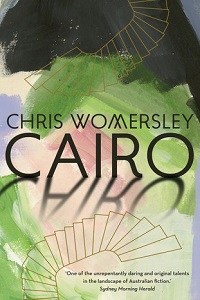
Title: Cairo
Author: Chris Womersley
Pages: 304
Published Date: 1 September 2013
Publisher: Scribe Publications
Series Details: Stand Alone
Publisher's Synopsis
Frustrated by country life and eager for adventure and excitement, seventeen-year-old Tom Button moves to the city to study. Once there, and living in a run-down apartment block called Cairo, he is befriended by the eccentric musician Max Cheever, his beautiful wife Sally, and their close-knit circle of painters and poets.
As Tom falls under the sway of his charismatic older friends, he enters a bohemian world of parties and gallery openings. Soon, however, he is caught up in more sinister events involving deception and betrayal, not to mention one of the greatest unsolved art heists of the twentieth century: the infamous theft of Picasso’s Weeping Woman.
Set among the demimonde — where nothing and nobody is as they seem — Cairo is a novel about growing up, the perils of first love, and finding one’s true place in the world.
My Review
Eighteen year old Tom Button wants to do what many small-town kids dream of, move to the big city to study and make a life for himself. He has definite plans of how he wants to make a life for himself and they involve the freedom of striking out on his own. When his Aunt Helen passes away leaving an apartment in Melbourne’s inner-city suburb of Fitzroy, he jumps at the chance to move in.
Cairo is a story based around the real life heist of Picasso’s Weeping Woman from the National Gallery of Victoria in 1986.
Early on, Tom flags the fact that there are going to be double-crosses and betrayals involved in this story. While the story is told from his first person perspective, it definitely gives the impression that it is being told from an older Tom, looking back on his younger, more innocent years.
Being a boy from the country whose head is filled with great pseudo-intellectual plans, Tom feels it necessary to make friends with his neighbours, to prove that he is part of the grown-up inner-city life.
The problem is, the neighbours he chooses draw him into a lifestyle of parties, gallery openings, art expositions and reflective cafe sojourns. His plans of enrolling in his Uni course are forgotten and he falls under the spell of the arty world of Max Cheever and his friends.
And while the young Tom is happy to ingratiate himself with Max, the older Tom looks back on his new-found friend with a more educated, weather eye:
“Foremost among Max’s talents was that of making everyone he encountered feel special merely by being in his company. It was an ability to divine – like a palm reader – what people wished to hear about themselves. I did not yet know that such a gift had a more sinister property; an ability to draw forth those aspects of one’s personality best kept under lock and key.”
What follows is a plot for the heist of the aforementioned Picasso work. Cheever and his arty acquaintances plan to forge a copy of the Weeping Woman, keep the original and then return the forgery to the gallery. (The plan accounts for the real-life events that took place in 1986).
Tom’s role in the caper is to be the driver, seeing as he’s the only one of the group who has access to a car.
The story is finely crafted, building an increasingly elaborate plot. From what, at first, seems like a harebrained scheme, it becomes at the very least vaguely possible to pull off.
That Tom has thrown his lot in with a band of artists hooked on heroin only becomes obvious once the job has been pulled. The Bolshie demands left for the police and the late night searches for drug dealers to supply more heroin starts to send their plan spiraling out of control.
Cairo is a solid crime novel, built around the art heist but bolstered by murder, double-crosses, forbidden love and infidelity and crafty red herrings.
It is also a coming-of-age story with Tom experiencing the joy and pain of partying hard, falling hard for an unattainable woman, making grand travel plans - the endless possibilities that only the young aspire to and then cling to desperately later.
The value and meaning of art is also put under the spotlight. Most notably by Gertrude, the artist in the group performing the forgery who, upon hearing that Tom has aspirations to become a famous author, puts this question to him:
“Do you think anyone would bother making a painting or a novel if they couldn’t attach their name to it? Artists talk about the joy of making work, but I wonder if they’d get so much of this so-called joy if they had no chance of being known for it. Would you write a novel if it was published anonymously? Because the forger doesn’t sign her name to a work, there is no ego involved. The pleasure is in the creation, in putting beautiful work into the world. It is as I said before, quite pure.”
The way in which this part of 1980s Melbourne is presented creates a heavy sense of nostalgia for those who’ve lived it. The Fitzroy drinking spots, the cafes and the Bohemian attitude of the locals are brought to life.
Part heist, part first-love story, part double-cross and ultimately betrayal, the story unfolds in a natural way, strolling along at the start before picking up momentum as it reaches its climax.
Chris Womersley once again proves himself to have a knack of evoking true emotion through the portrayal of the everyday world. The mundane Cairo Flats hosts a thriving hotbed of art thieves / forgers, druggies, wannabe literary bestsellers and Bolshie anarchists all presented in romantic melodrama.
And just for interests’ sake, the Cairo Flats on Nicholson St in Fitzroy actually exist. They were designed by architect Acheson Best Overend in 1935. Here’s a photo of the building.



